check engine light FORD EDGE 2013 1.G User Guide
[x] Cancel search | Manufacturer: FORD, Model Year: 2013, Model line: EDGE, Model: FORD EDGE 2013 1.GPages: 526, PDF Size: 5.98 MB
Page 285 of 526
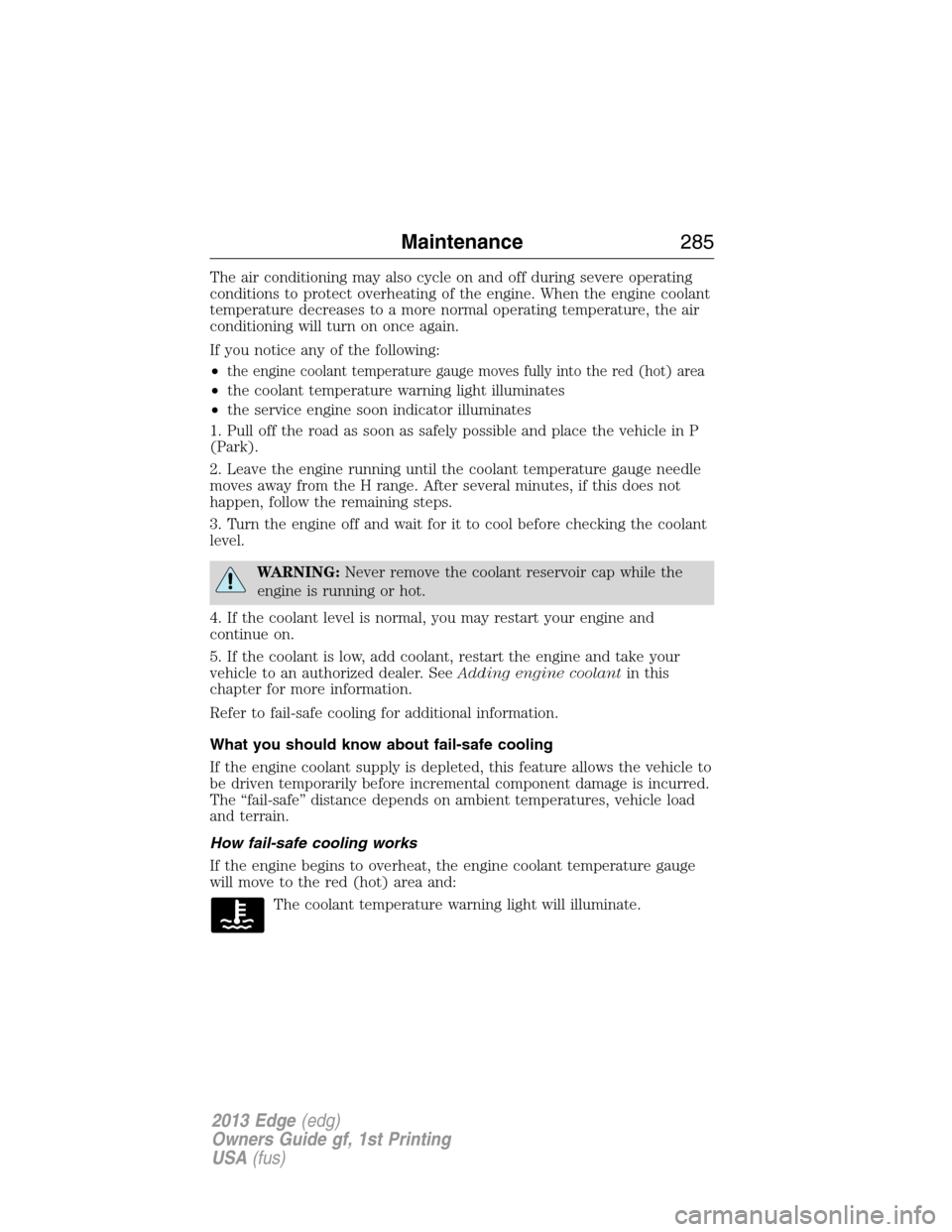
The air conditioning may also cycle on and off during severe operating
conditions to protect overheating of the engine. When the engine coolant
temperature decreases to a more normal operating temperature, the air
conditioning will turn on once again.
If you notice any of the following:
•
the engine coolant temperature gauge moves fully into the red (hot) area
•the coolant temperature warning light illuminates
•the service engine soon indicator illuminates
1. Pull off the road as soon as safely possible and place the vehicle in P
(Park).
2. Leave the engine running until the coolant temperature gauge needle
moves away from the H range. After several minutes, if this does not
happen, follow the remaining steps.
3. Turn the engine off and wait for it to cool before checking the coolant
level.
WARNING:Never remove the coolant reservoir cap while the
engine is running or hot.
4. If the coolant level is normal, you may restart your engine and
continue on.
5. If the coolant is low, add coolant, restart the engine and take your
vehicle to an authorized dealer. SeeAdding engine coolantin this
chapter for more information.
Refer to fail-safe cooling for additional information.
What you should know about fail-safe cooling
If the engine coolant supply is depleted, this feature allows the vehicle to
be driven temporarily before incremental component damage is incurred.
The “fail-safe” distance depends on ambient temperatures, vehicle load
and terrain.
How fail-safe cooling works
If the engine begins to overheat, the engine coolant temperature gauge
will move to the red (hot) area and:
The coolant temperature warning light will illuminate.
Maintenance285
2013 Edge(edg)
Owners Guide gf, 1st Printing
USA(fus)
Page 308 of 526
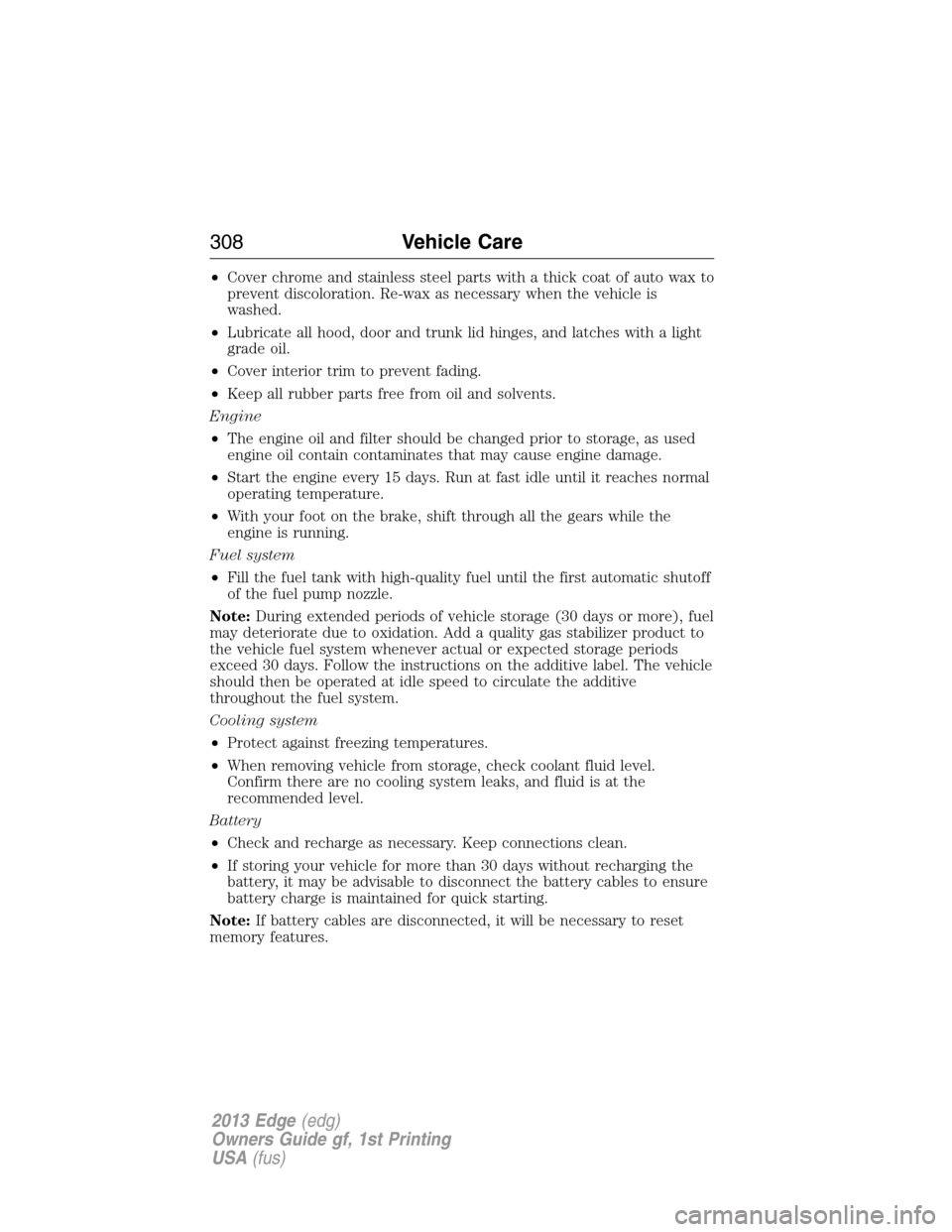
•Cover chrome and stainless steel parts with a thick coat of auto wax to
prevent discoloration. Re-wax as necessary when the vehicle is
washed.
•Lubricate all hood, door and trunk lid hinges, and latches with a light
grade oil.
•Cover interior trim to prevent fading.
•Keep all rubber parts free from oil and solvents.
Engine
•The engine oil and filter should be changed prior to storage, as used
engine oil contain contaminates that may cause engine damage.
•Start the engine every 15 days. Run at fast idle until it reaches normal
operating temperature.
•With your foot on the brake, shift through all the gears while the
engine is running.
Fuel system
•Fill the fuel tank with high-quality fuel until the first automatic shutoff
of the fuel pump nozzle.
Note:During extended periods of vehicle storage (30 days or more), fuel
may deteriorate due to oxidation. Add a quality gas stabilizer product to
the vehicle fuel system whenever actual or expected storage periods
exceed 30 days. Follow the instructions on the additive label. The vehicle
should then be operated at idle speed to circulate the additive
throughout the fuel system.
Cooling system
•Protect against freezing temperatures.
•When removing vehicle from storage, check coolant fluid level.
Confirm there are no cooling system leaks, and fluid is at the
recommended level.
Battery
•Check and recharge as necessary. Keep connections clean.
•If storing your vehicle for more than 30 days without recharging the
battery, it may be advisable to disconnect the battery cables to ensure
battery charge is maintained for quick starting.
Note:If battery cables are disconnected, it will be necessary to reset
memory features.
308Vehicle Care
2013 Edge(edg)
Owners Guide gf, 1st Printing
USA(fus)
Page 356 of 526
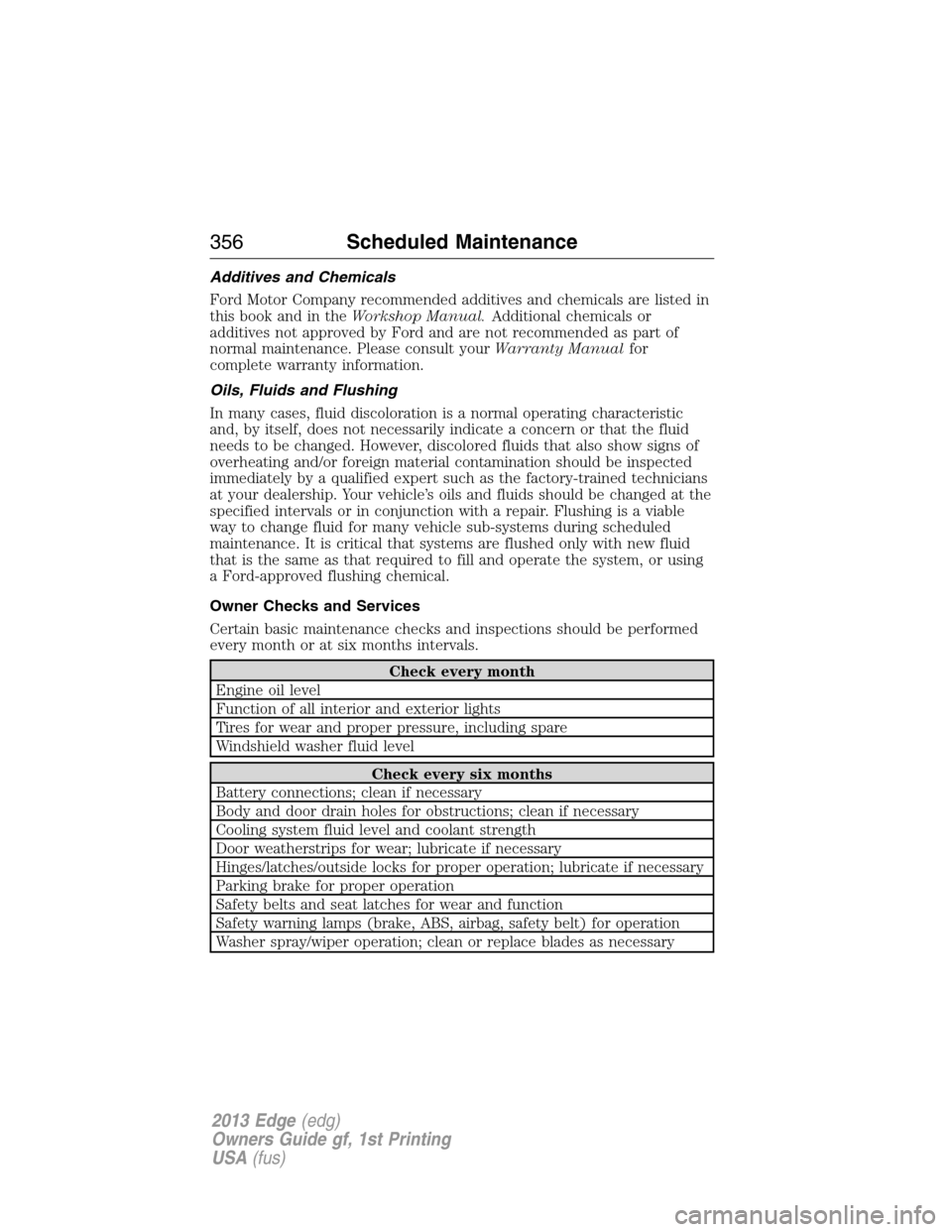
Additives and Chemicals
Ford Motor Company recommended additives and chemicals are listed in
this book and in theWorkshop Manual.Additional chemicals or
additives not approved by Ford and are not recommended as part of
normal maintenance. Please consult yourWarranty Manualfor
complete warranty information.
Oils, Fluids and Flushing
In many cases, fluid discoloration is a normal operating characteristic
and, by itself, does not necessarily indicate a concern or that the fluid
needs to be changed. However, discolored fluids that also show signs of
overheating and/or foreign material contamination should be inspected
immediately by a qualified expert such as the factory-trained technicians
at your dealership. Your vehicle’s oils and fluids should be changed at the
specified intervals or in conjunction with a repair. Flushing is a viable
way to change fluid for many vehicle sub-systems during scheduled
maintenance. It is critical that systems are flushed only with new fluid
that is the same as that required to fill and operate the system, or using
a Ford-approved flushing chemical.
Owner Checks and Services
Certain basic maintenance checks and inspections should be performed
every month or at six months intervals.
Check every month
Engine oil level
Function of all interior and exterior lights
Tires for wear and proper pressure, including spare
Windshield washer fluid level
Check every six months
Battery connections; clean if necessary
Body and door drain holes for obstructions; clean if necessary
Cooling system fluid level and coolant strength
Door weatherstrips for wear; lubricate if necessary
Hinges/latches/outside locks for proper operation; lubricate if necessary
Parking brake for proper operation
Safety belts and seat latches for wear and function
Safety warning lamps (brake, ABS, airbag, safety belt) for operation
Washer spray/wiper operation; clean or replace blades as necessary
356Scheduled Maintenance
2013 Edge(edg)
Owners Guide gf, 1st Printing
USA(fus)
Page 371 of 526
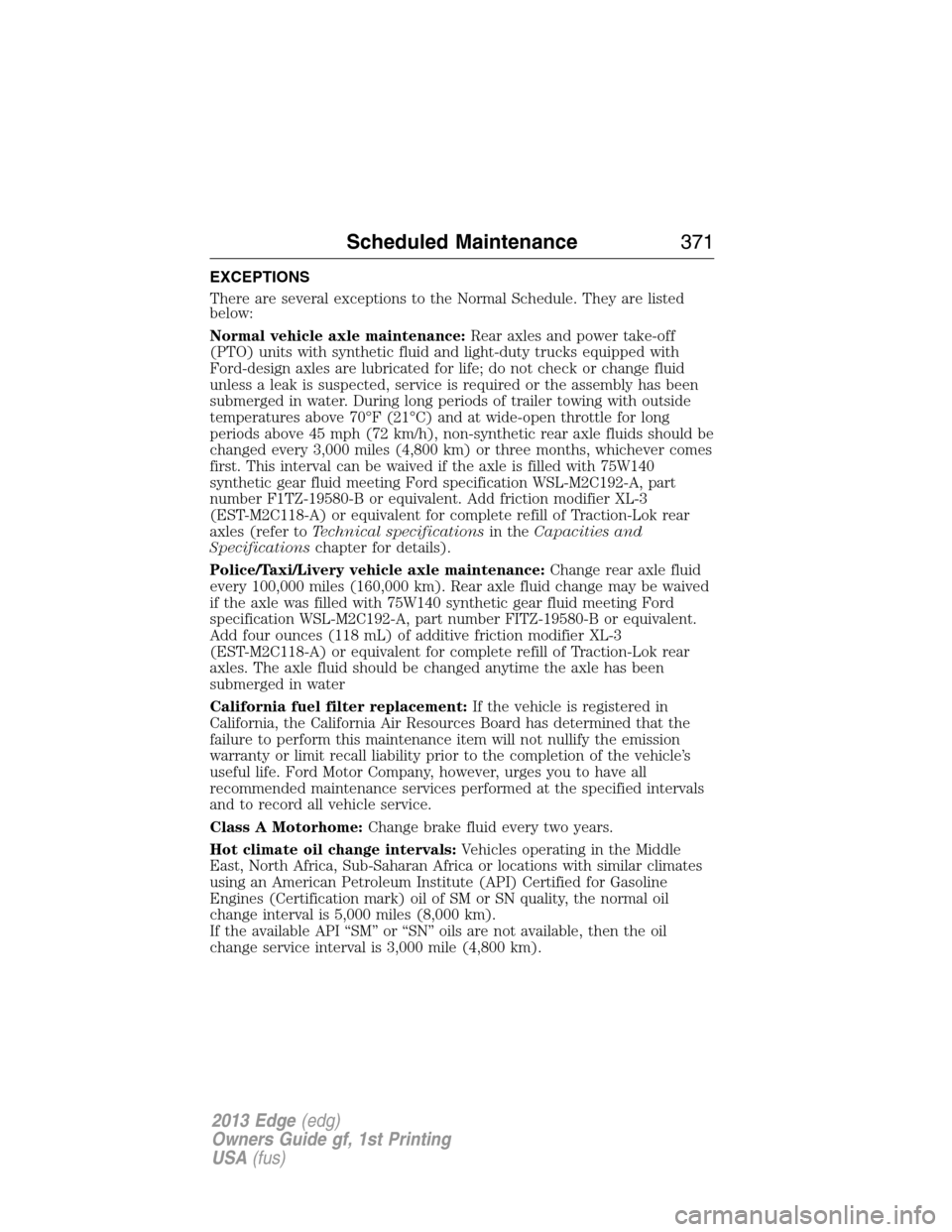
EXCEPTIONS
There are several exceptions to the Normal Schedule. They are listed
below:
Normal vehicle axle maintenance:Rear axles and power take-off
(PTO) units with synthetic fluid and light-duty trucks equipped with
Ford-design axles are lubricated for life; do not check or change fluid
unless a leak is suspected, service is required or the assembly has been
submerged in water. During long periods of trailer towing with outside
temperatures above 70°F (21°C) and at wide-open throttle for long
periods above 45 mph (72 km/h), non-synthetic rear axle fluids should be
changed every 3,000 miles (4,800 km) or three months, whichever comes
first. This interval can be waived if the axle is filled with 75W140
synthetic gear fluid meeting Ford specification WSL-M2C192-A, part
number F1TZ-19580-B or equivalent. Add friction modifier XL-3
(EST-M2C118-A) or equivalent for complete refill of Traction-Lok rear
axles (refer toTechnical specificationsin theCapacities and
Specificationschapter for details).
Police/Taxi/Livery vehicle axle maintenance:Change rear axle fluid
every 100,000 miles (160,000 km). Rear axle fluid change may be waived
if the axle was filled with 75W140 synthetic gear fluid meeting Ford
specification WSL-M2C192-A, part number FITZ-19580-B or equivalent.
Add four ounces (118 mL) of additive friction modifier XL-3
(EST-M2C118-A) or equivalent for complete refill of Traction-Lok rear
axles. The axle fluid should be changed anytime the axle has been
submerged in water
California fuel filter replacement:If the vehicle is registered in
California, the California Air Resources Board has determined that the
failure to perform this maintenance item will not nullify the emission
warranty or limit recall liability prior to the completion of the vehicle’s
useful life. Ford Motor Company, however, urges you to have all
recommended maintenance services performed at the specified intervals
and to record all vehicle service.
Class A Motorhome:Change brake fluid every two years.
Hot climate oil change intervals:Vehicles operating in the Middle
East, North Africa, Sub-Saharan Africa or locations with similar climates
using an American Petroleum Institute (API) Certified for Gasoline
Engines (Certification mark) oil of SM or SN quality, the normal oil
change interval is 5,000 miles (8,000 km).
If the available API “SM” or “SN” oils are not available, then the oil
change service interval is 3,000 mile (4,800 km).
Scheduled Maintenance371
2013 Edge(edg)
Owners Guide gf, 1st Printing
USA(fus)
Page 520 of 526
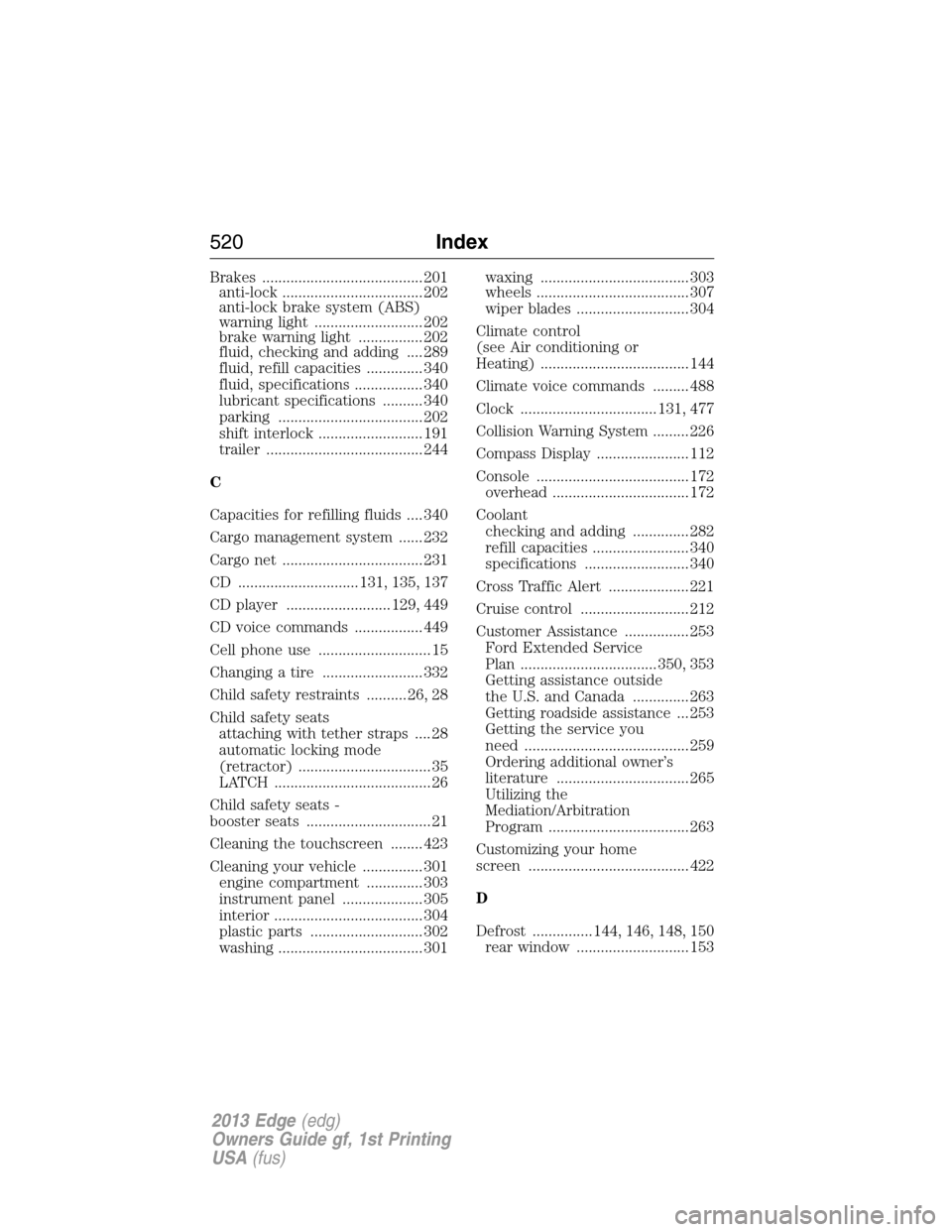
Brakes ........................................ 201
anti-lock ................................... 202
anti-lock brake system (ABS)
warning light ........................... 202
brake warning light ................ 202
fluid, checking and adding .... 289
fluid, refill capacities .............. 340
fluid, specifications ................. 340
lubricant specifications .......... 340
parking .................................... 202
shift interlock .......................... 191
trailer ....................................... 244
C
Capacities for refilling fluids .... 340
Cargo management system ...... 232
Cargo net ................................... 231
CD .............................. 131, 135, 137
CD player .......................... 129, 449
CD voice commands ................. 449
Cell phone use ............................ 15
Changing a tire ......................... 332
Child safety restraints .......... 26, 28
Child safety seats
attaching with tether straps .... 28
automatic locking mode
(retractor) ................................. 35
LATCH ....................................... 26
Child safety seats -
booster seats ............................... 21
Cleaning the touchscreen ........ 423
Cleaning your vehicle ............... 301
engine compartment .............. 303
instrument panel .................... 305
interior ..................................... 304
plastic parts ............................ 302
washing .................................... 301waxing ..................................... 303
wheels ...................................... 307
wiper blades ............................ 304
Climate control
(see Air conditioning or
Heating) ..................................... 144
Climate voice commands ......... 488
Clock .................................. 131, 477
Collision Warning System ......... 226
Compass Display ....................... 112
Console ...................................... 172
overhead .................................. 172
Coolant
checking and adding .............. 282
refill capacities ........................ 340
specifications .......................... 340
Cross Traffic Alert .................... 221
Cruise control ........................... 212
Customer Assistance ................ 253
Ford Extended Service
Plan .................................. 350, 353
Getting assistance outside
the U.S. and Canada .............. 263
Getting roadside assistance ... 253
Getting the service you
need ......................................... 259
Ordering additional owner’s
literature ................................. 265
Utilizing the
Mediation/Arbitration
Program ................................... 263
Customizing your home
screen ........................................ 422
D
Defrost ............... 144, 146, 148, 150
rear window ............................ 153
520Index
2013 Edge(edg)
Owners Guide gf, 1st Printing
USA(fus)